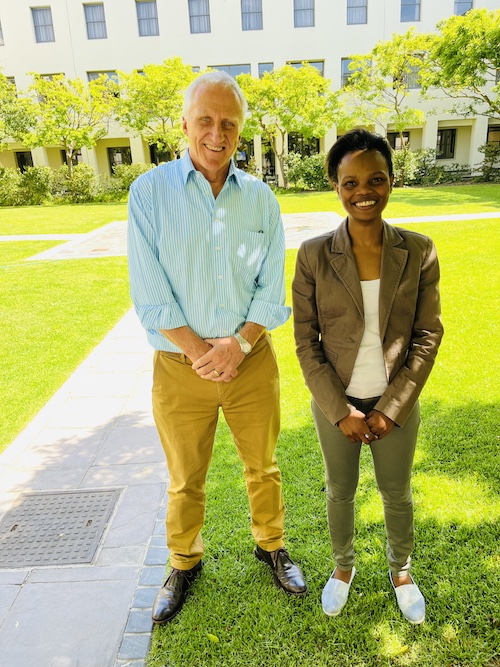
At the UCT Graduate School of Business, the case method forms an important part of our pedagogy on the MBA programme. It is here that the dilemmas of real African businesses are brought to life through robustly researched cases and the stimulating, if challenging, classroom experiences led by our faculty. An important part of the process for creating cases that maximise student learning and engagement, and drive home the right business lessons, is the in-class test-teaching of new cases. The moment a case enters the classroom is when it truly becomes the educational tool at the core of the MBA.
Last spring saw the test-teach session for one of the Case Writing Centre’s newest cases: “Umoya: Respiratory device innovation in the health sector during a crisis”. The Umoya case follows the South African social enterprise as it disrupts the healthcare device space through its unconventional approach to product innovation. Researched and written by CWC case writer Thabile Bhengu, the case tracks the Umoya team’s agile approach to developing a respiratory device in response to the shortage of respiratory care in South Africa at the onset of the Covid-19 pandemic. It then explores the innovative business model Umoya develops following its swift transition from a non-profit organisation into a social enterprise.
“Umoya is a purpose-driven organisation with the potential to make a high impact in the medical device area. The case is highly appropriate for students interested in how to scale social enterprises and how to overcome challenges with growth, product development, and market introduction, as well as how to maintain and grow a purpose-driven organisation with loosely connected stakeholders,” said Professor Mikael Samuelsson, who specialises in entrepreneurship strategy at the GSB.
With a focus on business scaling and lean product development, the case was perfect for Prof Samuelsson’s MBA elective course Venture Exploitation, designed for students that have or want to develop for-profit and non-profit scale-ups.
“It is intriguing to discuss how to create a sustainable organisation with a core of being purpose-driven and a team with different skill sets and the intricacies of scaling such an organisation in emerging economies,” Prof Samuelsson said.
Prof Samuelsson takes a dynamic approach to case teaching, bringing in real-life cases and getting students to perform an interactive analysis in the classroom. For Umoya, students were assigned the case as a pre-reading in preparation for a classroom discussion. Over the course of an hour, Samuelsson unpacked the Umoya case in detail with the MBA students by orchestrating a discussion around the key issues of the organisation’s novel approach to product innovation and their transition from a non-profit into a social enterprise. Students were then asked to propose recommendations for how Umoya could redefine its organisational structure in preparation for scale-up while maintaining their core vision and values and their agile approach to product development.
But this case test session was made especially memorable by another feature. Prof Samuelsson further brought the case to life for students by inviting the director of Umoya and the case protagonist, Dave Morris, into the classroom. Morris, who is an engineer and project manager at Umoya, opened the session by sharing the company's business journey and stayed on to hear how students perceived the organisation’s challenges.
Getting case protagonists into the classroom can be an invaluable addition to the learning experience, making it clear that cases are not theoretical exercises but representations of real people who were actually faced with the case challenges and made tough decisions. It also gives students a chance to get answers to questions that go beyond the case pages, straight from the source.
But the case-teaching experience can be equally important for the case subjects that take the time to engage with business students. At the end of the session, Morris got to hear from students their ideas – and questions – for Umoya’s future.
“The classroom experience was incredibly valuable for us. The thought-provoking discussions raised a number of questions we [Umoya] need to answer about our future and our sustainability. Front and foremost is the creation of a future story which enhances our sustainability yet can be implemented while retaining the ethos and humanity which is the glue that holds us together. I’m looking forward to further interactions,” said Morris.
Morris was referring to Umoya’s ongoing evolution following their Covid-era success. Since the launch of its flagship respirator device, the OxERA®, Umoya has continued to develop medical healthcare devices sought after even by organisations that work with the WHO.
And of course, the value of case test sessions – especially those that include the case protagonist – accrews directly to the case researchers and writers. It can highlight information gaps in the case that might be tripping students up, or if the discussion questions are effective for surfacing the learning objectives of the case. It can also reveal different interpretations of the data that can add new dimensions to the case. For instance, students in the Umoya session were very focussed on the tradeoff they perceived between Umoya’s agility and their impending restructuring.

Accordingly, the additional engagement with students and protagonists during test teaching is an opportunity for case writers to get inspiration for new cases. For instance, recognising the level of neglect in South Africa’s rural public health facilities, such as the reliable supply of essential lifesaving consumables like oxygen, Umoya’s multi-disciplinary team has since extended its offerings to project management services. One of their projects is the installation of an on-site oxygen generation plant for Madwaleni Hospital in rural Eastern Cape. Perhaps it’s a story for the sequel.
Read the case
To find out more about the Umoya case, contact Claire Barnardo at the UCT GSB Case Writing Centre.










